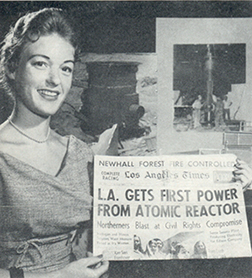Located in the Simi Hills in between Simi Valley and the San Fernando Valley in Southern California,the Santa Susana Field Laboratory (SSFL) is an industrial research and development facility currently focusing on rocket engine development. Currently a Superfund site, the SSFL has been under major investigation concerning their toxic waste management and disposal procedures over the years. The focus of this page is an overview of this facility and its history, a look into the environmental concerns, controversies and incidents that have occurred here and the current cleanup plans and projects for the site.
Brief History[edit | edit source]
Operating since 1947 the SSFL has worked to greatly advance the nuclear energy and rocket technology industries. Originally operated by Rocketdyne, the site is now owned by Boeing. The site had originally been chosen for its remoteness due to the nature of the facility, but the population grew immensely in the subsequent years in the surrounding area. Rocket testing operations ceased in 2006. Nuclear research operations ceased earlier in 1988. Although still relatively unknown, the lab was also the site of several accidents both from negligence and accidents that led to both local environmental harm and resulted in some deaths.
Rocket Engine Research and Development[edit | edit source]
The SSFL has helped to create many different rocket engines. These have been used in different types of cruise missiles and in Apollo rocket components all the way to the space shuttle's main engine.[1] NASA currently owns part of the site and conducted joint operations with Rocketdyne and Boeing.
Nuclear Energy Research and Development[edit | edit source]
The site also began hosting a nuclear energy research and testing facility in 1953 commissioned by the Atomics International division of North American Aviation (NAA).[2] This part of the site, also called Area IV, had what is considered the countrie's first commercial nuclear power plant as its output was used to power the nearby city of Moorpark starting in 1957.[3]
Accidents and Contamination[edit | edit source]
The full extent of all the toxins released into the local area watershed and air by the SSFLs projects are still unknown. The site has been covered in a cloud of secrecy since it's inception due to the nature of the experiments.

Sodium Reactor Experiment[edit | edit source]
The Sodium Reactor Experiment (SRE) was one of the first reactors to provide power to ordinary consumers. The idea started under President Eisenhower and the 'Atoms for Peace' program. The designing of the reactor began in 1954 and construction was finished in 1957. Soon after, the reactor began to power the nearby city of Moorpark, CA and was considered a major achievement garnering a front page article in the Los Angeles Times. The reactor used liquid sodium instead of water to cool the cores.
Meltdown[edit | edit source]
In July, 1959 the SRE experienced a partial meltdown of one-third of the total fuel cells. This site was also built before many regulations for nuclear facilities were put in place and there was no concrete structure encasing the main reactor. The operators intentionally vented radioactivity from the reactor for weeks following the incident. News of the meltdown was not released to the public for 5 weeks and it was merely reported that a "parted fuel element had been observed."[4] The amount of radioactive waste to enter the air remains unknown to this day due to missing documents, conflicting reports, government disclosure regulations, and lies by the operators.[5]
The actual cause of the meltdown was from faulty pumps that were clogged when another type of coolant being used accidentally mixed in with the liquid sodium preventing the reactor from cooling. This was found to be occurring before the actual meltdown took place, but the reactor continued to be used and experimented with for two weeks after a major "power excursion." During this time the core was repeatedly purged with nitrogen gas, which was released into the atmosphere each time. Nuclear physicist, Dr. Arjun Makhijani of the Institute for Energy and Environmental Research estimates that the amount of radioactive iodine released was 260 times more than what was estimated for the Three Mile Island incident.[6] This was not the final nuclear accident to occur at SSFL.
Water Contamination[edit | edit source]
Burn Pits[edit | edit source]
References[edit | edit source]
- ↑ Boeing's main website about the SSFL.
- ↑ The Dept. of Energy's description of the nuclear research facility at SSFL and it's closure.
- ↑ California Energy Commission's list of California nuclear power plants.
- ↑ Statement by Daniel Hirsch, President of the Committee to Bridge the Gap before the Committee on Environment and Public Works, US Senate.
- ↑ "Hidden Truth: The Sodium Reactor Experiment Meltdown of 1959 at the Santa Susana Field Laborotory" Brian Rodgers.
- ↑ Quote by Dr. Arjun Makhijani from Statement by Daniel Hirsch. Page 4.